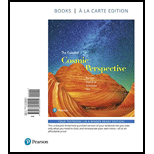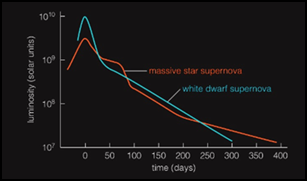
Essential Cosmic Perspective, The, Books a la Carte Edition (8th Edition)
8th Edition
ISBN: 9780134532455
Author: Jeffrey O. Bennett, Megan O. Donahue, Nicholas Schneider, Mark Voit
Publisher: PEARSON
expand_more
expand_more
format_list_bulleted
Concept explainers
Question
Chapter 14, Problem 1VSC
To determine
How bright the white dwarf supernova is compared to the massive star supernova.
Expert Solution & Answer
Answer to Problem 1VSC
Solution: Approximately 10 times.
Explanation of Solution

The y axis in the plot is in logarithmic scale. Hence, the peak brightness of massive supernova is around
Conclusion: The white dwarf supernova is 10 times brighter than massive star supernova.
Want to see more full solutions like this?
Subscribe now to access step-by-step solutions to millions of textbook problems written by subject matter experts!
Students have asked these similar questions
A
I
squar frame has sides that measure 2.45m when it is at rest.
What is the area of the frame when it moves parellel to one
of
its diagonal with a
m²
speed of 0.86.c as indicated in the figure?
>V.
An astronent travels to a distant star with a speed of 0.44C
relative to Earth. From the austronaut's point of view, the star
is 420 ly from Earth. On the return trip, the astronent travels
speed of 0.76c relative to Earth. What is the distance
covered on the return trip, as measured by the astronant?
your answer in light-years.
with a
Give
ly.
star by spaceship
Sixus is about 9.00 ly from Earth. To preach the star
in
15.04 (ship time), how fast must you travel?
C.
Chapter 14 Solutions
Essential Cosmic Perspective, The, Books a la Carte Edition (8th Edition)
Ch. 14 - Prob. 1VSCCh. 14 - Prob. 2VSCCh. 14 - Prob. 3VSCCh. 14 - Prob. 4VSCCh. 14 - Prob. 5VSCCh. 14 - Prob. 1EAPCh. 14 - Prob. 2EAPCh. 14 - Prob. 3EAPCh. 14 - Prob. 4EAPCh. 14 - Prob. 5EAP
Ch. 14 - Prob. 6EAPCh. 14 - Prob. 7EAPCh. 14 - Prob. 8EAPCh. 14 - Prob. 9EAPCh. 14 - Prob. 10EAPCh. 14 - Prob. 11EAPCh. 14 - Prob. 12EAPCh. 14 - Prob. 13EAPCh. 14 - Prob. 14EAPCh. 14 - Prob. 15EAPCh. 14 - Prob. 16EAPCh. 14 - Prob. 17EAPCh. 14 - Prob. 18EAPCh. 14 - Prob. 19EAPCh. 14 - Prob. 20EAPCh. 14 - Prob. 21EAPCh. 14 - Prob. 22EAPCh. 14 - Prob. 23EAPCh. 14 - Prob. 24EAPCh. 14 - Gravitational waves are best observed with the...Ch. 14 - Prob. 26EAPCh. 14 - Prob. 27EAPCh. 14 - Prob. 28EAPCh. 14 - Prob. 29EAPCh. 14 - Prob. 30EAPCh. 14 - Prob. 31EAPCh. 14 - Which of these binary systems is most likely to...Ch. 14 - Viewed from a distance, how would a flashing red...Ch. 14 - Which of these black holes exerts the weakest...Ch. 14 - Prob. 35EAPCh. 14 - Prob. 36EAPCh. 14 - 37. Unanswered Questions. You have seen in this...Ch. 14 - Prob. 38EAPCh. 14 - Prob. 39EAPCh. 14 - Prob. 40EAPCh. 14 - Prob. 41EAPCh. 14 - Prob. 42EAPCh. 14 - Prob. 43EAPCh. 14 - Prob. 44EAPCh. 14 - Prob. 45EAPCh. 14 - Surviving the Plunge. The tidal forces near a...Ch. 14 - Prob. 47EAPCh. 14 - Prob. 48EAPCh. 14 - Prob. 49EAPCh. 14 - Prob. 50EAPCh. 14 - Prob. 51EAPCh. 14 - Prob. 52EAPCh. 14 - Prob. 53EAPCh. 14 - Prob. 54EAPCh. 14 - Prob. 55EAPCh. 14 - Prob. 56EAP
Knowledge Booster
Learn more about
Need a deep-dive on the concept behind this application? Look no further. Learn more about this topic, physics and related others by exploring similar questions and additional content below.Similar questions
- (a) For a spherical capacitor with inner radius a and outer radius b, we have the following for the capacitance. ab C = k₂(b- a) 0.0695 m 0.145 m (8.99 × 10º N · m²/c²)( [0.145 m- 0.0695 m × 10-11 F = PF IIarrow_forwardA pendulum bob A (0.5 kg) is given an initialspeed of vA = 4 m/s when the chord ishorizontal. It then hits a stationary block B (1kg) which then slides to a maximum distanced before it stops. Determine the value of d.The coefficient of static friction between theblock and the plane is μk = 0.2. The coefficientof restitution between A and B is e = 0.8.Ans: d=1.0034 marrow_forwardFigure 29-43 Problem 12. ••13 In Fig. 29-44, point P₁ is at distance R = 13.1 cm on the perpendicular bisector of a straight wire of length L = 18.0 cm carrying current i = 58.2 mA. (Note that the wire is not long.) What is the magnitude of the magnetic field at P₁ due to i? P2° R R Larrow_forward
- Checkpoint 1 The figure shows the current i in a single-loop circuit with a battery B and a resistance R (and wires of neg- ligible resistance). (a) Should the emf arrow at B be drawn pointing leftward or rightward? At points a, B C R b, and c, rank (b) the magnitude of the current, (c) the electric potential, and (d) the electric potential energy of the charge carriers, greatest first.arrow_forwardPls help ASAParrow_forwardPls help asaparrow_forward
arrow_back_ios
SEE MORE QUESTIONS
arrow_forward_ios
Recommended textbooks for you
 College PhysicsPhysicsISBN:9781305952300Author:Raymond A. Serway, Chris VuillePublisher:Cengage Learning
College PhysicsPhysicsISBN:9781305952300Author:Raymond A. Serway, Chris VuillePublisher:Cengage Learning University Physics (14th Edition)PhysicsISBN:9780133969290Author:Hugh D. Young, Roger A. FreedmanPublisher:PEARSON
University Physics (14th Edition)PhysicsISBN:9780133969290Author:Hugh D. Young, Roger A. FreedmanPublisher:PEARSON Introduction To Quantum MechanicsPhysicsISBN:9781107189638Author:Griffiths, David J., Schroeter, Darrell F.Publisher:Cambridge University Press
Introduction To Quantum MechanicsPhysicsISBN:9781107189638Author:Griffiths, David J., Schroeter, Darrell F.Publisher:Cambridge University Press Physics for Scientists and EngineersPhysicsISBN:9781337553278Author:Raymond A. Serway, John W. JewettPublisher:Cengage Learning
Physics for Scientists and EngineersPhysicsISBN:9781337553278Author:Raymond A. Serway, John W. JewettPublisher:Cengage Learning Lecture- Tutorials for Introductory AstronomyPhysicsISBN:9780321820464Author:Edward E. Prather, Tim P. Slater, Jeff P. Adams, Gina BrissendenPublisher:Addison-Wesley
Lecture- Tutorials for Introductory AstronomyPhysicsISBN:9780321820464Author:Edward E. Prather, Tim P. Slater, Jeff P. Adams, Gina BrissendenPublisher:Addison-Wesley College Physics: A Strategic Approach (4th Editio...PhysicsISBN:9780134609034Author:Randall D. Knight (Professor Emeritus), Brian Jones, Stuart FieldPublisher:PEARSON
College Physics: A Strategic Approach (4th Editio...PhysicsISBN:9780134609034Author:Randall D. Knight (Professor Emeritus), Brian Jones, Stuart FieldPublisher:PEARSON

College Physics
Physics
ISBN:9781305952300
Author:Raymond A. Serway, Chris Vuille
Publisher:Cengage Learning

University Physics (14th Edition)
Physics
ISBN:9780133969290
Author:Hugh D. Young, Roger A. Freedman
Publisher:PEARSON

Introduction To Quantum Mechanics
Physics
ISBN:9781107189638
Author:Griffiths, David J., Schroeter, Darrell F.
Publisher:Cambridge University Press

Physics for Scientists and Engineers
Physics
ISBN:9781337553278
Author:Raymond A. Serway, John W. Jewett
Publisher:Cengage Learning

Lecture- Tutorials for Introductory Astronomy
Physics
ISBN:9780321820464
Author:Edward E. Prather, Tim P. Slater, Jeff P. Adams, Gina Brissenden
Publisher:Addison-Wesley

College Physics: A Strategic Approach (4th Editio...
Physics
ISBN:9780134609034
Author:Randall D. Knight (Professor Emeritus), Brian Jones, Stuart Field
Publisher:PEARSON